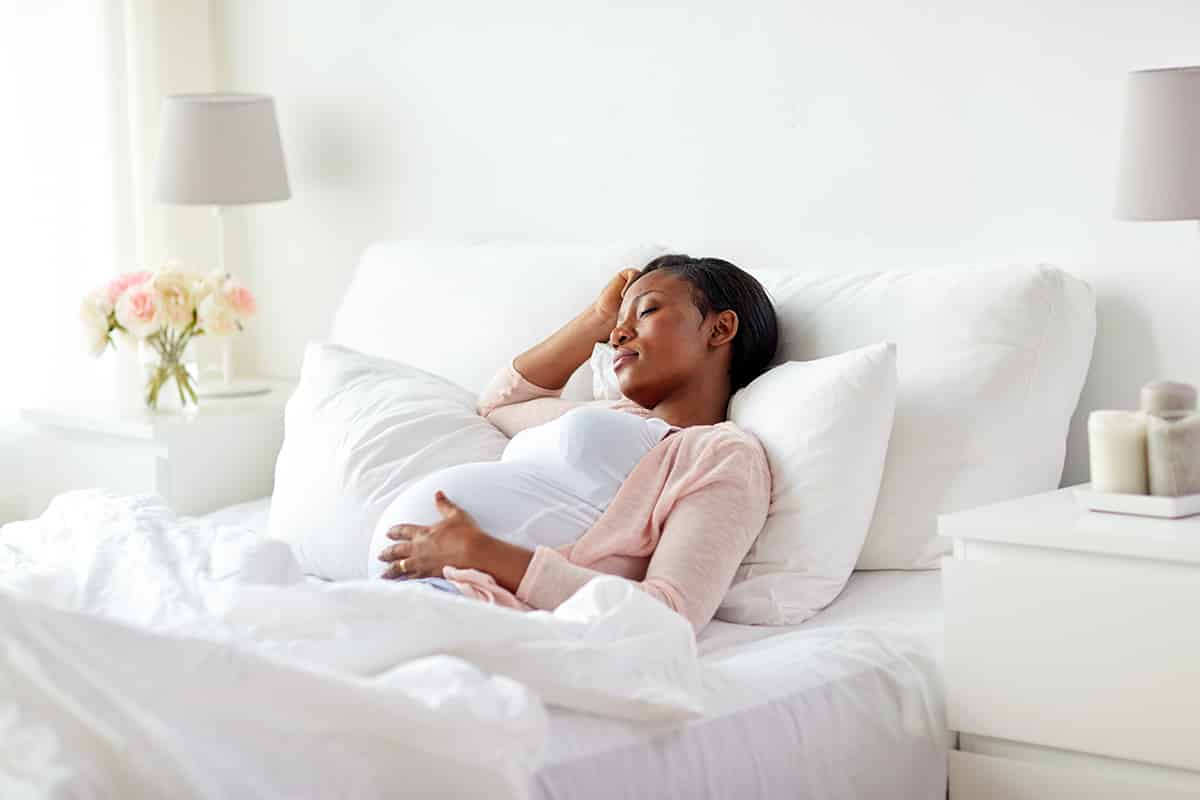It’s no secret that a lot of Americans are sleep-deprived. In fact, one-third of American adults report that they aren’t getting enough sleep on a regular basis, according to the Centers for Disease Control and Prevention (CDC). Inadequate sleep is associated with many negative health outcomes, including changes in mood and the ability to retain information, as well as physical obesity, diabetes, and cardiovascular disease.
But it’s not just sleep quantity that can affect your health. How you sleep can play a role in a restful night’s sleep, too. What’s more, research shows that the most beneficial sleep position can actually change as you get older or experience different health issues.
For those navigating pregnancy, back or neck pain, or nocturnal sleep issues like snoring or acid reflux, here’s what to know about the best sleeping positions to keep you more comfortable at night.
Best Sleeping Position for Back Pain: On Your Back or Side with Assistance
Experts recommend side and back (supine) sleeping for those who have a back problem – you just need a strategically placed pillow. That’s because poor spinal alignment aggravates existing back pain (and often leads to new aches and pains). Here’s what they recommend:
- Back: Placing a pillow under your knees will help maintain the normal curve of your lower back. You might also try a small, rolled towel under the small of your back for additional support.
- Side: Place a small or full-length pillow in between your legs and draw your legs up slightly towards your chest. That will help align your pelvis and hips, while also taking pressure off the spine.
Stomach sleeping isn’t recommended if you have back pain, because it puts pressure on the spine. If you find it impossible to sleep in a different position, try using a pillow beneath your hips and lower abdomen to help reduce back strain.
Best Sleeping Position for Snoring: On Your Side or Inclined
Research suggests that the supine sleep position aggravates snoring. That’s because snoring is the result of obstructions caused by the tongue, soft palate, and muscles of the throat, which relax during sleep and can droop enough to disrupt air flow and cause vibrations. To minimize snoring, it’s important to sleep in a manner that helps open the upper airways.
- Side: Depending on the severity of your snoring, sleeping on your side could do the trick.
- Inclined: According to one study, repositioning the upper body to an inclined position with a special pillow or adjustable base is a non-obtrusive way to reduce snoring and improve sleep.
Best Sleeping Position for Pregnancy: On Your Side
Doctors generally advise sleeping on your side when you’re pregnant, and the left side may be best. That’s because this position allows for optimal blood flow in a large vein that runs down the spine and carries blood to both your heart and your baby. According to one review, however, it’s just as safe to sleep on your right side as it is on your left.
If possible, try to avoid sleeping on your back or stomach, especially later in pregnancy. Some research has found an association between these positions and an increased risk for pregnancy complications, including stillbirth.
Experts recommend sleeping with your knees bent and using pillows to add support. Place a pillow between your knees, beneath your belly, and behind your back to help relieve pressure on your spine and hips.
Best Sleeping Position for Acid Reflux: On Your Left Side or Inclined
To minimize symptoms of nocturnal acid reflux, the stomach should be below the esophagus to keep food or acid from creeping up the digestive tract. That means there are two options for sleeping.
- Left side: There is some research to suggest that side sleeping may help relieve symptoms of nocturnal acid reflux. A small 2022 study with 100 patients found that those who slept on their left side experienced more reflux-free nights.
- Inclined: Other research finds that an elevated sleep position, accomplished either with pillows or by raising the top of the bed with blocks, may also be effective for relieving symptoms.
Best Sleeping Position for Neck Pain: On Your Back or Side
Research shows that stomach sleeping is particularly tough on the spine due to the arched back and turned head throughout the night, which can result in neck pain. Because of this, back and side sleeping are recommended to minimize potential neck issues. However, in both positions, it’s important that you use a pillow that supports your neck and head and maintains neutral alignment.
- Back: Use a pillow that’s soft but supportive enough to cradle the base of your neck and keep the head in a neutral position.
- Side: Use a pillow with just enough loft to fill the space between your head and your shoulder against the mattress. A pillow that’s too soft will let your head sink down too far, triggering neck pain. A pillow that’s too firm or thick can push the head upward, likewise straining the neck.
Best Sleeping Position for Hemorrhoids: On Your Stomach or Side
Hemorrhoids are inflamed veins and tissue in the anus and lower rectum that can cause significant discomfort, especially by the end of the day. While there are no clinical studies investigating the best sleep position if you have hemorrhoids, the most likely best approach is minimizing pressure and irritation in the anal region. That makes stomach and side sleeping the most comfortable options.
- Stomach: Sleeping in a prone position can put pressure on your low back, so it’s important that you have a mattress with enough support to elevate the hips properly. Make sure you have a low pillow to minimize neck strain as well.
- Side: A pillow between your knees can help support your hips and align the pelvis, while also reducing hemorrhoid pressure.
Best Sleeping Position for Hip Pain: On Your Back or Side
The hip is a sensitive pressure point, and loading it with excessive weight while you sleep can lead to pain. For those with hip pain, back and side sleeping may be best.
- Back: Back sleeping is beneficial because it distributes your body weight more evenly, which prevents either hip from bearing too much strain. Placing a pillow under your knees or lower back can also reduce the pressure on your hips while back sleeping.
- Side: If you experience hip pain on just one side of your body, sleeping on your other side could be a good option (so if your left hip hurts, you would want to sleep on your right side). Similarly, side sleepers can place a pillow under or between their knees to achieve similar pressure relief.
Best Sleeping Position for Arthritis: Varies
Arthritis pain can vary greatly from person to person, so there really is no single sleep position that is best for people with arthritis. In general, the best way to reduce arthritis pain while sleeping is in a position that maintains spinal alignment.
Depending on the type of pain you experience, you may find one position does that more comfortably than another. For example, someone with knee or hip pain may find that side or back sleeping with a pillow under their knees could provide some relief. Additionally, those experiencing back pain from arthritis may find it helpful to sleep on their sides with a pillow between their knees.
Frequently Asked Questions
What is the healthiest position to sleep in?
There really isn’t a single healthiest sleep position, because individual body types and health conditions have an enormous influence on what’s comfortable and supportive. However, sleeping on your back or side is generally considered healthier than sleeping on your stomach. That’s because it reduces pressure on the neck and spine. However, people with specific health conditions, such as obstructive sleep apnea, may find that sleeping on their back triggers more symptoms. Those who are pregnant or with nocturnal sleep apnea often sleep best on their side.
Does sleeping in a certain position matter?
Sleeping positions can affect your quality of sleep. But if you aren’t experiencing issues, there is likely no reason to change your sleep position.
Why do we change positions while sleeping?
There is little to no research that explains why we change positions while we’re sleeping, but there are theories. Some sleep specialists believe that changing positions while we sleep is a natural mechanism that helps avoid the problems associated with the pressure of laying the same way all night long. Others assume it’s simply related to getting more comfortable.
Final Thoughts
There may be a sleep position that’s most appropriate for you based on your body type and any health conditions. During pregnancy, for example, back sleepers are advised to sleep on their sides to protect the developing fetus. People who snore or experience nocturnal acid reflux may find relief by sleeping in an inclined position or on their sides. Being aware of the sleep position that best accommodates your needs can help you get a better night’s sleep.



